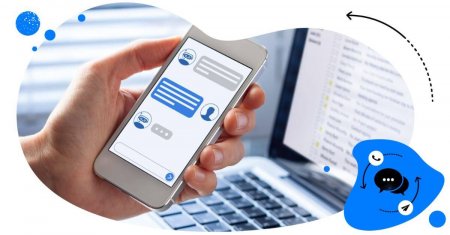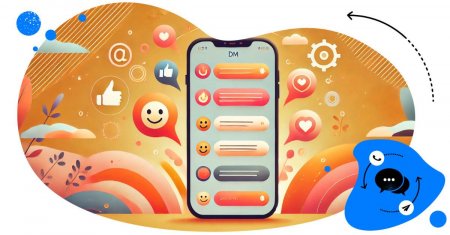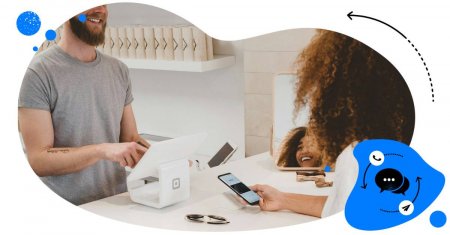Table of Contents
- What is outbound engagement?
- The role of outbound engagement in customer acquisition
- Key components of effective outbound engagement
- How NapoleonCat enhances outbound engagement
- Optimizing team workflows with NapoleonCat’s workspaces
- Best practices for outbound engagement
- Case study: How teams thrive with NapoleonCat's outbound engagement tools
- Get better at engagement – both inbound and outbound
- Outbound engagement - FAQs
There’s one element that often gets missed when brands are building their presence on social media – and it’s missed because it tends to take time and resources companies often don’t have.
That element is outbound engagement, and I’m here to show you how to optimize your social media marketing efforts to make the most of it and reap the benefits.
- What is outbound engagement?
- The role of outbound engagement in customer acquisition
- Key components of effective outbound engagement
- How NapoleonCat enhances outbound engagement
- Optimizing team workflows with NapoleonCat’s workspaces
- Best practices for outbound engagement
- Case study: How teams thrive with NapoleonCat's outbound engagement tools
- Get better at engagement – both inbound and outbound
- Outbound engagement – FAQs
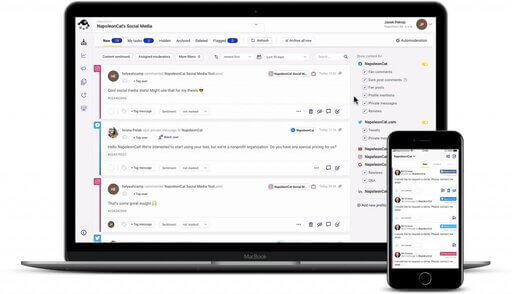
Outbound engagement made easier
Use NapoleonCat to manage and automate all your comments, messages, and more – with an all-in-one social media tool that supports Facebook, Instagram, TikTok, LinkedIn, YouTube, Google My Business, and more.
What is outbound engagement?
Outbound engagement on social media is essentially taking the first step in starting conversations with your audience. Instead of sitting back and waiting for customers to come to you, you actively reach out – comment on their posts, reply to their stories, send DMs, or even engage with people who haven’t heard of your brand yet.
It includes outbound campaigns, participating in hashtags, sending personalized DMs, and building influencer relationships. And it’s kind of a mindset shift – from reactive to proactive. Many brands are great at handling inbound engagement – responding to comments, customer service inquiries, or DMs. But outbound engagement is like taking a step further. It shows you’re not just a passive participant but an active member of your community.
Imagine you work for a clothing brand, and are scrolling through Instagram to find posts where people are asking for outfit recommendations. When you comment with helpful advice (without being overly promotional), you’ll add value to the conversation and also put your brand in front of new people who might not have discovered it otherwise.
That’s outbound engagement in action.
Disclaimer: No, it’s not spamming strangers with sales pitches. It’s thoughtfully joining conversations where your brand can add value – and in turn, creating opportunities for customer acquisition.
And while it sounds simple – you know, just commenting, liking, or messaging – it does require strategy, consistency, and the right tools to scale effectively. (Because – spoiler alert – it also takes time.)
Like anything in marketing (sorry to be the bearer of bad news! 🙈)
The role of outbound engagement in customer acquisition
When you think about how people buy today, it’s rarely a straight line. They might stumble across your brand in their feed, see a friend mention you, or notice your comment on a trending post. And the point of outbound engagement is to create more of these kinds of touchpoints.
And how does that play into customer acquisition? Well:
- Visibility. When you engage in conversations outside of your own posts, more people see your brand name. Essentially, it’s digital word-of-mouth.
- Building trust. When you show up consistently in relevant discussions, your brand earns credibility points. People start seeing you as approachable and knowledgeable, and not just another business selling products.
- Lead generation. Outbound engagement helps you spot potential customers in real time. When you reply to someone asking for recommendations on a product or service, it could easily turn into a sale on social media.
- Building communities. Customers are more likely to stick with brands that feel human and relatable – that’s hardly news. Consistent proactive outbound engagement is really effective at creating that sense of community and connection. (I do need to stress “consistent”, though.)
I don’t think I have to say it, but I will say it – when it comes to customer acquisition (but also brand building), outbound engagement is not a silver bullet. (Because no single marketing tactic is.)
Instead, it’s an important element of the entire marketing puzzle, and should be balanced with other marketing activities for best results. So, just a friendly reminder in case you needed it. 😉

One inbox for all social media interactions
Use NapoleonCat to manage all your comments, messages, and more – with an all-in-one social media tool that supports Facebook, Instagram, TikTok, LinkedIn, YouTube, Google My Business, and more.
Key components of effective outbound engagement
To make outbound engagement that effective part of your social strategy, several pieces need to come together:
1. Consistency
You can’t just pop in once a month to a random person’s comments and expect results. (Well, you can, but the results you’ll see? I don’t know about that.)
Community engagement needs to be a regular activity. Like networking (and real life, really) – you build stronger relationships the more you show up. There’s no magic here.
2. Relevance
Random “Nice post!” comments are probably not going to be enough. Your interactions should feel genuine and consistent with your brand’s personality. That means listening first, then adding something meaningful to the conversation.
3. Timeliness
Engaging in a conversation while it’s happening is far more impactful than chiming in days later. Being quick helps your brand stay part of the trend and increases visibility.
All of which makes social media listening a key part of outbound engagement. By monitoring brand mentions and selected keywords and phrases, you can come to the conversation as it’s unfolding.
4. Personalization
Personalization remains one of the key elements of marketing in general, not just when it comes to outbound engagement. Personalized responses show people you actually care.
So, instead of copy-pasting the same comment, tailor your message based on what the person shared. Yes, it’s not as straightforward, but definitely much more effective, if you’re looking for actual results.
5. Team collaboration
For larger teams or agencies, outbound engagement needs smart coordination. Otherwise, you risk duplicating efforts or missing opportunities. Structured workflows are key to making sure the right person handles the right interaction.
6. Tools
As with anything in marketing, you also need smart tools to help you coordinate teams, find relevant conversations, and optimize participating in them. In fact, let’s talk about one of these tools – NapoleonCat.
How NapoleonCat enhances outbound engagement
NapoleonCat is a suite of features designed to streamline social media engagement, both inbound and outbound. So that your team can focus on meaningful conversations instead of getting lost in the social media noise.
Let me show you how that works with the different engagement-focused features of the platform.
Social Inbox: Streamlining communication for teams
The Social Inbox is the foundation of NapoleonCat. It collects all comments, mentions, messages, and reviews from multiple platforms into one dashboard.
For outbound engagement, this is a game-changer. Instead of checking notifications on every platform separately, your team can:
- Spot opportunities for proactive engagement – See when your brand is tagged or mentioned, jump into conversations right away, and turn casual mentions into sales leads.
- Assign tasks – If a potential lead comes up, you can assign it to a customer service rep or sales team member directly from the Inbox.
- Collaborate in real time – Team members can leave internal notes, share context, and coordinate responses, both when it comes to outbound and inbound engagement. This is a whole ‘nother level of efficiency.
- And – maybe most of all – manage all your inbound engagement in one place. So you have more time for outbound engagement.
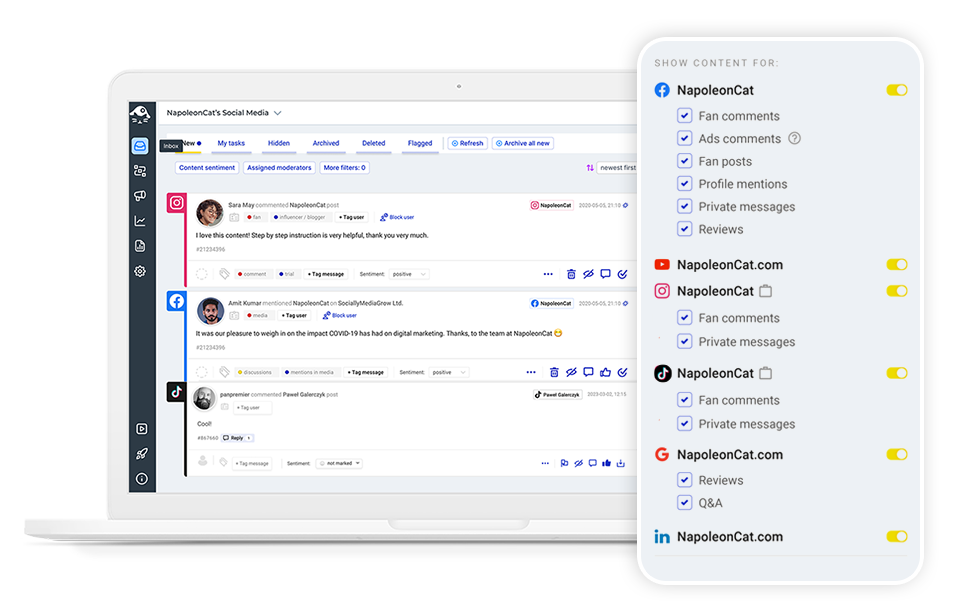
Social CRM: Centralizing customer data for smarter engagement
The Social CRM stores customer interaction histories, notes, and tags in one place to give you what’s key in every conversation: context.
For outbound engagement, this means:
- You don’t start from scratch every time. You know who you’re talking to – a previous customer, a lead, an influencer, etc.
- You know whether someone has interacted with your brand before and what kind of interactions these have been.
- When you comment on their posts, you can make the interaction more relevant and personal, making the outreach more effective.
Here is what a user profile looks like in NapoleonCat. You can add your custom tags and internal notes, and even connect it to your online store sales.
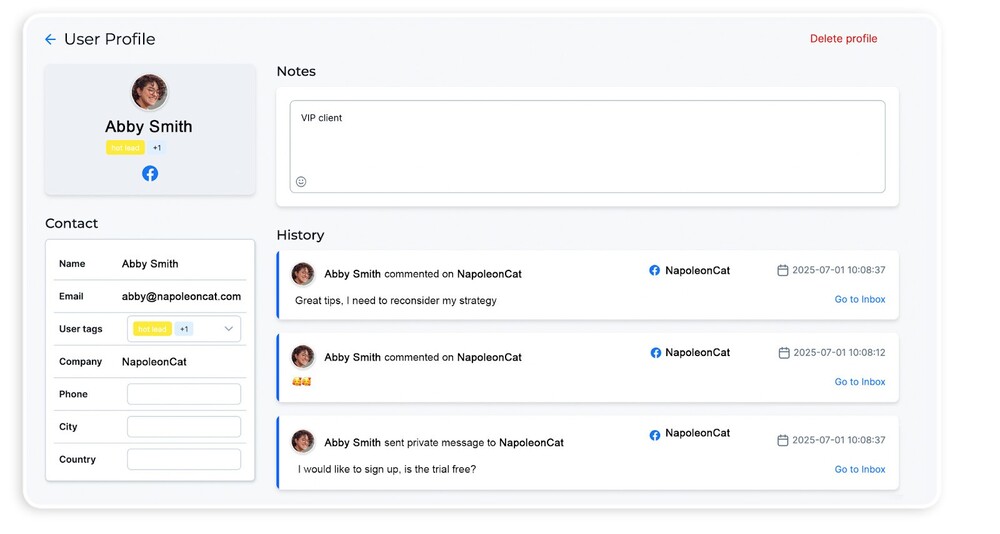
AI Assistant: Automatically categorize conversations
Sorting through hundreds (or thousands) of conversations can be overwhelming. (Said our good ol’ friend, Captain Obvious.)
NapoleonCat’s AI Assistant uses machine learning to automatically categorize and prioritize messages, helping you weed out the unimportant (or worse, damaging) stuff automatically.
In the context of outbound engagement, it’ll help your team:
- Instantly evaluate a comment’s sentiment, speeding up relevant action-taking.
- Distinguish between customer support queries, engagement opportunities, and plain spam or hate, which muddle the waters and keep adding more work for your team, who can’t focus on the valuable conversations.
- Avoid PR crises and react quickly to complaints that you might otherwise miss. (And don’t forget – a complaint that’s been solved quickly and in a helpful way might actually turn into a sales opportunity.)

You can also use what the AI Assistant finds to trigger automated actions like spam removal or auto-replies using Auto-moderation rules (coming up next ⬇️)
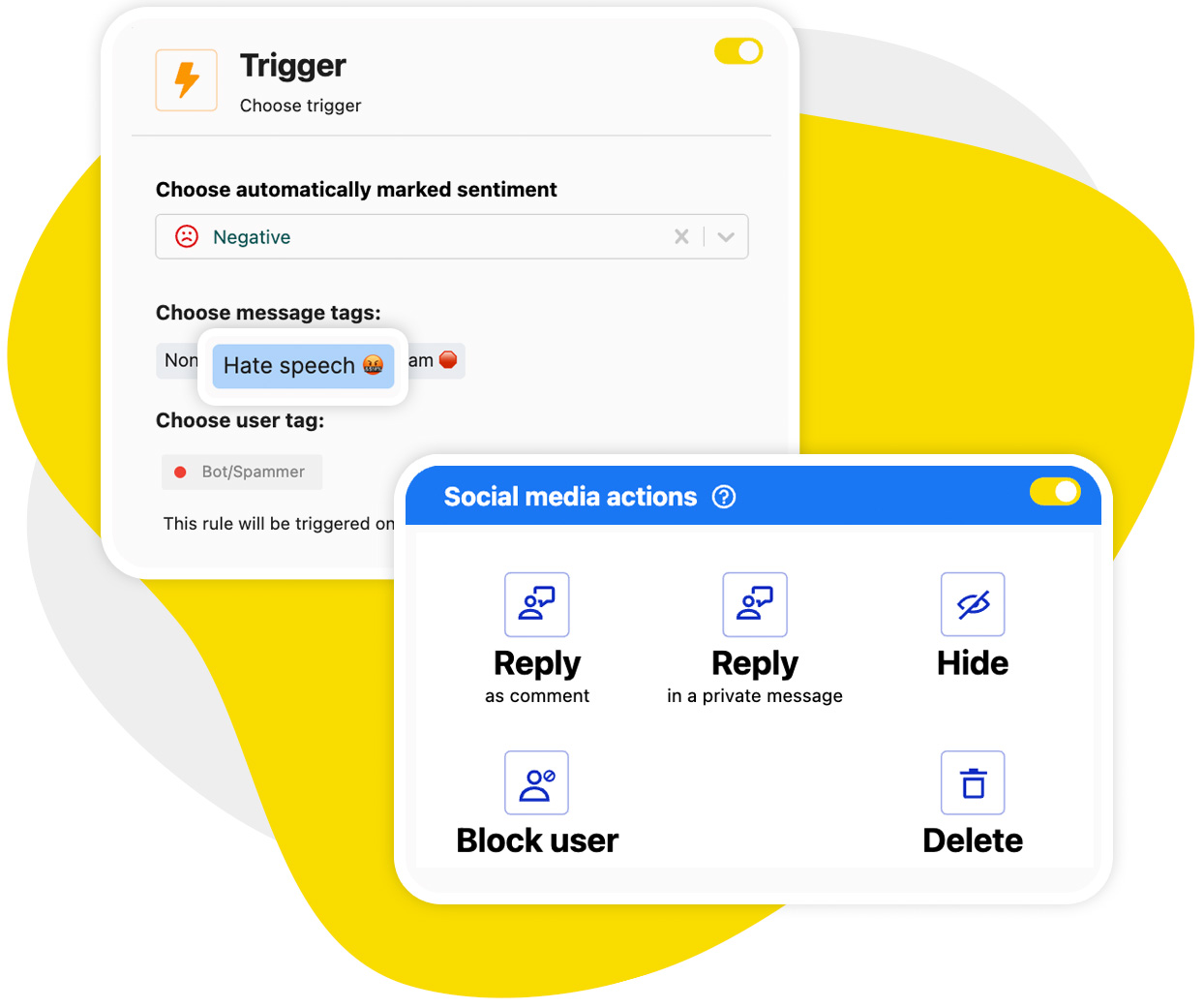
Auto-moderation: Automatically manage conversations and spam
Speaking of Auto-moderation – it’s a way to automate some of your customer interactions to make your team more productive and eliminate overwhelm when the workload is just too much. Because, yes, spam, bots, and repetitive comments eat up valuable time and focus.
With Auto-moderation, NapoleonCat filters out the clutter:
- Removes spam comments automatically.
- Responds with predefined replies to repetitive questions.
- Flags sensitive comments for team review.
This way, your team can gain much more time for outbound engagement and jump into conversations that actually matter.
You can also automatically respond to profile mentions on Facebook – think of it as an autoresponder letting your audience know you’ve seen the message and will be back with a helpful answer, even if this happens on a weekend.
Or you can instantly assign it to a moderator, who’ll know what to do.
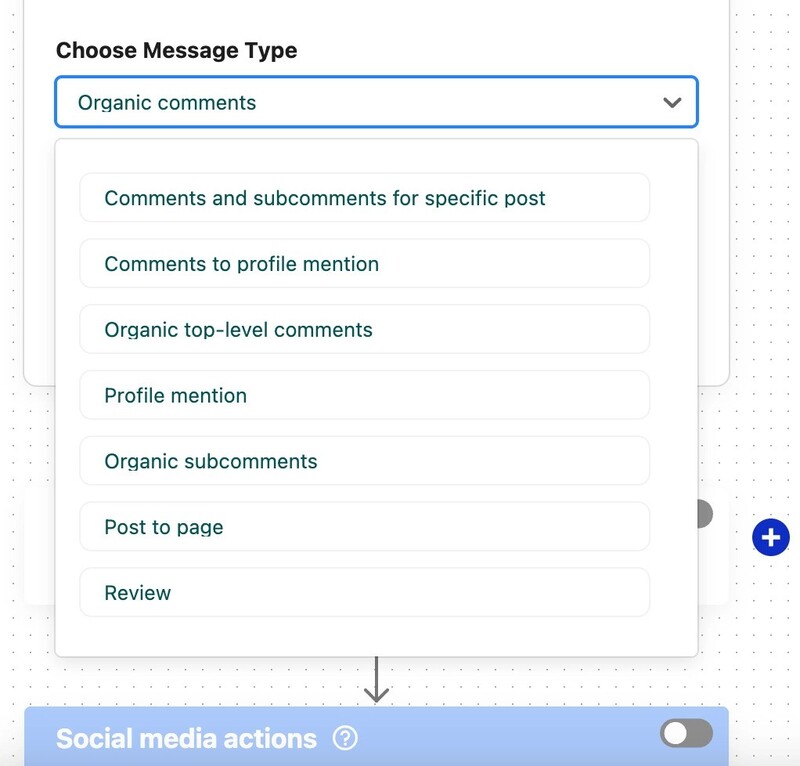

Automatically Block Spam with AI Precision
Automatically hide or delete spam and hate comments on your posts and ads across all your social media profiles, powered by advanced AI.
Optimizing team workflows with NapoleonCat’s workspaces
For teams handling multiple social accounts (or agencies managing multiple clients), organization is everything. Without it, tasks tend to stretch out, chaos creeps in, and it’s much harder to find time for outbound engagement (it’s never the right time when there’s always “something more important” like an angry customer complaining in the DMs.)
With NapoleonCat’s Workspaces, you can create separate environments for different brands, projects, or teams, depending on your internal workflows.
And what does it change exactly?
- Teams know exactly which accounts they’re responsible for.
- Engagement efforts don’t overlap or get lost in the social media and corporate noise.
- You can manage permissions and roles to keep workflows clear.
- You can set up different tags for different workspaces, adjust what the AI Assistant does, add alerts, and set up different Auto-moderation rules.
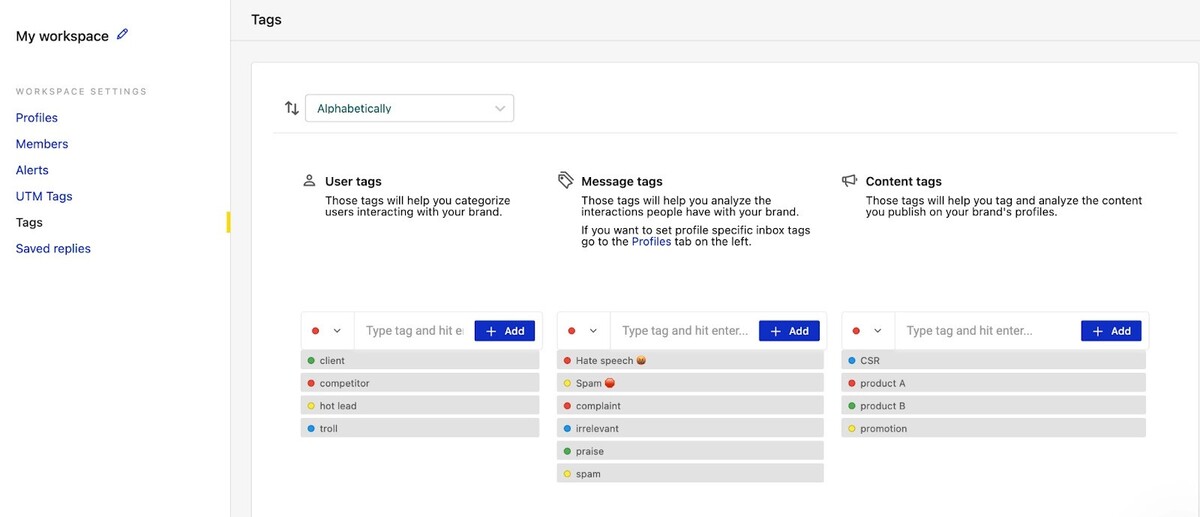
Best practices for outbound engagement
When you have the tools, finding the time for outbound engagement becomes much easier. But tools won’t solve everything – you need to have a plan, goals, and ways to go after them. So here are some tips to make outbound engagement actually worthwhile.
- Define your goals.
Are you trying to build awareness, generate leads, or increase loyalty? Your approach will most likely vary depending on the outcome you want.
- Set brand guidelines.
Create a tone of voice guide for outbound comments. This will help consistency (it’s key, remember?), especially if multiple people are engaging on behalf of your brand.
- Balance quality and quantity.
Don’t just chase numbers. A few meaningful interactions can have more impact than dozens of generic ones (especially with all the AI slop out there these days – you don’t want to be mistaken for those!)
- Analyze your results.
Track which types of outbound interactions drive engagement or conversions, and then refine your approach. Rinse, repeat. You can do that with NapoleonCat, too.
- Automate what you can.
Use tools like Auto-moderation to clear the noise, but keep outbound comments human and authentic. If you’re using Auto-moderation to reply to profile mentions, create different reply versions so you’re not always firing up the same canned response.
- Be human.
Outbound engagement is all about connection (just as social media is, in general. At least in theory.) Speak like a person, not a press release or a sales letter. That’s not what this is about.

One inbox for all social media interactions
Use NapoleonCat to manage all your comments, messages, and more – with an all-in-one social media tool that supports Facebook, Instagram, TikTok, LinkedIn, YouTube, Google My Business, and more.
Case study: How teams thrive with NapoleonCat’s outbound engagement tools
Let’s take a look at how NapoleonCat’s clients actually use the platform to handle both inbound and outbound engagement on social media for their respective clients.
White Bits: Automating engagement for multiple clients
White Bits is a digital communications agency handling both organic content and ad campaigns for multiple brands, all generating high volumes of comments across platforms.
Manually moderating this ecosystem is as inefficient as it is risky, with some interactions slipping through the cracks.
With NapoleonCat:
- All comments from all platforms flow into a unified dashboard.
- Team members can quickly spot urgent threads, collaborate, and pick up where someone else left off, keeping response times fast and seamless.
- The platform’s conversation history is indispensable as team members can jump in without missing context. (And remember what we said about context?)
- The result? More efficiency, more reliable responses, and a scalable workflow for outbound campaigns and reactive engagement.
“NapoleonCat gives us the full picture of social media interactions. It’s easier to pick up urgent threads that need taking immediate action. And with conversation history, it’s much easier to continue the work of another team member while they’re out of office.”
Aldona Nalewajk, Social Communications Consultant
Read the full case study
VPA: Turning comment chaos into customer service wins
VPA, an Australian eCommerce supplement brand, was grappling not just with comments on posts but especially under paid ads, where customer questions, spam, and feedback were piling up. This is also a proven recipe for brands not to have time for outbound engagement whatsoever.
What they did using NapoleonCat:
- Centralized comment moderation from TikTok, Instagram, Facebook, and beyond into the Social Inbox.
- Made it exceptionally easy for the customer service team to locate, respond, or hide comments, directly improving the customer experience and engagement rate.
- This is also exactly what any brand needs for higher-quality outbound interactions – faster, smoother, and more aligned with customer expectations.
“The customer service team is really happy that it is so easy to navigate, easy to find and respond to comments, and you can easily hide comments when necessary.”
Kathleen Belleza, VPA Australia
Read the full case study
Plej: Delivering results – and job satisfaction – for moderators
Plej is a Warsaw-based marketing and event agency juggling comment moderation and DMs across multiple clients. Their goals were speed and meaningful engagement combined, often under ads and with high message volume.
Using NapoleonCat:
- They separated each client into its own Workspace, keeping work neatly organized.
- The team could consult comment threads with clients directly within the platform for collaborative, on-brand responses.
- During spikes in volume, Auto-moderation stepped in to handle repetitive tasks, so moderators could focus on high-value interactions.
- All this translates to more time for inbound and outbound engagement, smoother workflows, and a better experience for both moderators and clients.
“We work with multiple clients, and with NapoleonCat, we don’t waste time switching between multiple software tools. We can also deliver reliable data from a single source. We tested other social media moderation and analytics tools before, but none of them lived up to what NapoleonCat delivers. They’re the best, and I personally love using the tool. :)”
Karol Gagatko, Head of Communication, Plej
Read the full case study
Bien Agency: From publishing to analytics, all in one place
Bien Agency manages over 50 clients across social media, handling everything from content, publishing, and comment moderation to analytics and reporting.
With NapoleonCat at their core:
- They structure workflows by client using Workspaces and user roles.
- Publishing is centralized – no more hopping between dashboards or platforms. (And yes, NapoleonCat also lets you schedule and publish content from the same platform.)
- Comment moderation (organic and paid) is streamlined through the Social Inbox.
- Auto-moderation cuts through spam and repetitive queries.
- Automated reports keep clients informed with minimal manual effort.
All this helps turn continuous customer engagement into an efficient, integrated process, with performance and client satisfaction both rising.
“It’s hard to imagine our work without a tool that includes so many valuable features. It won’t be an overstatement when I say that NapoleonCat saves us multiple full-time positions that would be dedicated to just moderating comments or manually generating reports.”
Wojciech Biendzio, Bien Agency
Read the full case study
Get better at engagement – both inbound and outbound
Whether outbound or inbound, building social media engagement takes time. And the right tools will help you get more of it, optimizing your workflows and giving you the best social media has to offer.
For a sneak peek of how it might work for your brand or agency, try NapoleonCat completely for free for two weeks and see how much more time you have for outbound engagement by the time the free trial ends. 👀

One inbox for all social media interactions
Use NapoleonCat to manage all your comments, messages, and more – with an all-in-one social media tool that supports Facebook, Instagram, TikTok, LinkedIn, YouTube, Google My Business, and more.
Outbound engagement – FAQs
Got more questions about outbound engagement? Here are the most common FAQs answered in one place.
What is outbound engagement?
Outbound engagement is proactively starting conversations on social media:
- commenting on others’ posts
- joining discussions
- reaching out to people who may not yet know your brand (including commenting and sending DMs).
What is the difference between inbound and outbound engagement?
Inbound engagement is reactive: you respond to people who interact with your brand (their messages and comments).
Outbound engagement is proactive: you reach out to others and start the interaction yourself, even when someone is not writing directly to you (though they might be talking about you or something relevant to your brand.)
What is the meaning of outbound marketing?
Outbound marketing refers to pushing your brand message out to audiences (like ads, cold calls, or emails). Inbound marketing, on the other hand, is responding to people who come to you – for example, use Google to search for something and come across your relevant content.
Outbound engagement, while related, is more conversational, focused on genuine interactions rather than one-way promotions.
What is an outbound comment?
An outbound comment is when your brand comments on someone else’s post. It’s one of the most direct and effective ways to practice outbound engagement.

Outbound engagement made easier
Use NapoleonCat to manage and automate all your comments, messages, and more – with an all-in-one social media tool that supports Facebook, Instagram, TikTok, LinkedIn, YouTube, Google My Business, and more.
You may also like:
- All-in-One Social Inbox: Reply to Everything in One Place
- Team Inbox for Social Media: Everything in One View
- How to Manage All Social Media in One Place – Facebook, TikTok, Instagram, and more
- Social Media Comment Management: Full Expert Guide
- Support Your Team With a Social Media Moderation Tool They Deserve
- Pre-Customer Service on Social Media: Insights & Tips
- Multi-Account Social Media Management: Full Guide
- How to Create and Manage Multiple Instagram Accounts Like a Pro
- How to Manage Multiple Facebook Pages More Easily
- How to Manage Multiple LinkedIn Accounts (without going mad)
- Top 15 Social Media Management Tools for Teams
- How to Use Automated Customer Service on Social Media



